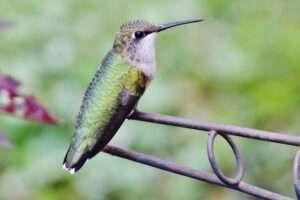June and early July is when our Ruby-throated Hummingbirds are nesting in central and eastern Kansas. This year, like many years, homeowners who have had hummingbirds reliably during June and early July, suddenly find that they have none or not the number that they are used to having. Which results in the question of concern, “Where are my hummingbirds?”
Hummingbirds start returning to Kansas in mid-April, peaking in mid-May and then declines rapidly as only the nesting birds remain. While migration of Ruby-throated Hummingbirds can occur across much of the state, nesting is limited to the eastern half of Kansas. When birds migrate north they often do so with a south wind. When winds shift to the north, migration stalls, until the wind next shifts around to the south. This spring we had many days of north winds effectively stalling migration for several days in a row. Once the wind shifts back to the south, birds take flight with a new urgency to get to their breeding grounds. With Ruby-throated Hummingbirds nesting into southern Canada, some of them had a long way to go once they left here. Many species of birds, once the wind shifted to the south, completely flew over normal stop over points within the state. Hummingbirds still in eastern Kansas by mid-June are going to be nesting individuals.
Like all species, hummingbird populations are somewhat cyclical in nature and will go through surges and retractions in populations. The overall population trends for Ruby-throated Hummingbird is very positive given data from the annual Breeding Bird Surveys. But the hummingbirds that perhaps nested in your yard for the past several years may have been lost to natural catastrophes or predators over the winter or simply succumbed to old age. Maintaining feeders and hummingbird friendly landscaping will encourage hummingbirds to normally return within a year or two. In some cases, there are also major, or sometime relatively minor, changes to a neighborhood landscape that can cause the hummingbirds to decide to nest elsewhere.
Southbound hummingbird migration starts cranking up the end of July, will peak in mid to late August, and continue on through September into very early October. Homeowners can continue to maintain hummingbird feeders during this period. But if you are seeing no activity at your feeders, you may choose to take the feeders down until about July 20th. As a reminder, red dye is not recommended in the feeder nectar and it will be most cost efficient to just use table sugar and water at the rate of 1-part sugar to 4-parts water. Be sure to change nectar every day or two in extremely hot weather.





